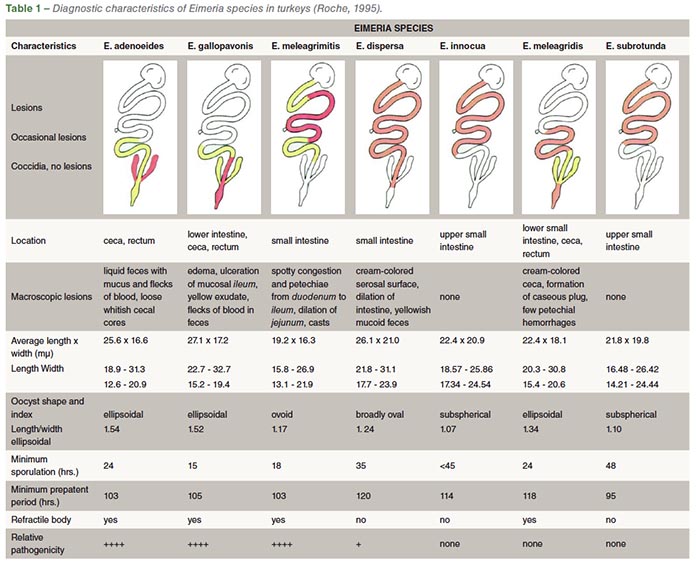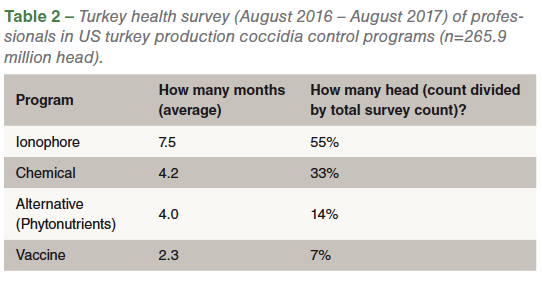
Coccidiosis is a disease that is caused by protozoan parasites that develop within the intestine of most domestic and wild animals and birds. Coccidia were recognized as parasites of turkeys in the United States as early as 1895.
Seven species of coccidia infect turkeys. Four of these, Eimeria meleagrimitis, E. adenoeides, E. gallopavonis and E. meleagridis are considered to be among the most pathogenic of the species and have been identified repeatedly in the major turkey producing areas of the world.
Each species invades and develops in a specific, defined area of the intestine. The parasitized area of the intestine increases with severe infections and some species develop along the entire length. Diagnosis and speciation are usually determined by location of the infection in the intestine, the appearance of the droppings or intestinal contents, and the presence, size and shape of the oocysts. The potential for a marked increase in the incidence of coccidiosis in turkeys has occurred in recent years because of the rapid growth of the turkey industry and the movement No Antibiotics Ever (NAE) production methods. However, the efficacy of currently used anticoccidial medications and vaccines has controlled, to a large degree, clinical coccidiosis in the field.
Several types of protozoa are associated with enteric disease of turkeys. Protozoal enteritis can present with general signs, including dehydration, loss of appetite (off-feed), loose droppings and watery intestinal contents. Flagellated protozoa include Cochlosoma, Tetratrichomonas, Histomonas and Hexamita. Coccidia Cryptosporidia and Eimeria are non-flagellated protozoa of turkeys. Cochlosoma and Hexamita have recently been associated with enteritis, primarily in young turkeys, especially in the summer months. There are field reports of co-infections with Cochlosoma and Tetratrichomonas, or Cochlosoma and Hexamita, or flagellated protozoa and Eimeria. Diagnosis is confirmed by mucosal scrapings and microscopic examination at 400X magnification.

“E. edgari is highly pathogenic in turkeys …” new species of Eimeria can be found in about 6 of every 10 samples from commercial turkey flocks around the US, as well as in wild turkeys. E. edgari was first confirmed by Parasitologist Dr. Fitz-Coy and since diagnosed by veterinarians across the country. This small-spherical coccidia, smaller than other turkey oocysts, is most predominant in the upper and mid-intestine. E. edgari is associated with enteritis, watery intestinal contents with focal areas of orange-tinged mucus in duodenum and jejunum, resulting in uneven bird sizes and mortality and flushing.
Coccidiosis management
An effective coccidiosis control program in turkeys involves the use of anticoccidial medications and/or phytonutrients and/or live vaccines and the subsequent development of immunity. Coccidiosis increased from #13 to #6 ranking in a 2017 turkey industry survey of 36 health issues, most likely reflecting the industry increasing raised without antibiotics (RWA) and no antibiotics ever (NAE) market. RWA and NAE programs do not permit the use of ionophore anticoccidials and many programs prohibit FDA approved chemical anticoccidials, so anticoccidial programs consist of alternatives or vaccination. An effective coccidiosis control program in turkeys involves the use of anticoccidial medications and/or phytonutrients (alternatives) and/or live vaccines and the subsequent development of immunity. Table 2 summarizes the US turkey production coccidia control products (n=265.9 million head) and ionophores represent the majority, 55% of heads for an average use of 7.5 months during the 12-month survey period. Chemical anticoccidials account for 33% head and 4.5 months. Coccidia vaccination was limited to 7% head; the low incidence might be in part due to the restricted availability 2016-2017 of the only USDA approved commercial turkey coccidiosis live vaccine. Nutritional dietary supplementation with phytonutrients (alternatives) is becoming more popular, reported at 14% head, either via in-feed application or drinking water administration.
 Anticoccidials are products used to combat coccidiosis in poultry. After the infective sporulated oocysts are ingested, the sporozoites invade the intestinal cells and then mature. The sporozoites mature through asexual and sexual stages. It is during the asexual stage that the coccidia are most damaging to the intestine, especially if left uncontrolled by an effective anticoccidial and a strong immune system. A number of medications have been approved for use against turkey coccidiosis and fall into different classes: divalent ionophores including lasalocid (Avatec® and monovalent ionophores including monensin (Coban® are most commonly used to stimulate immunity. Synthetic anticoccidials, such as zoalene (Zoami® or SDM+OMP (RofenAid®), may be used in rotation programs throughout the year, or a shuttle program in the same flock, with ionophores.
Anticoccidials are products used to combat coccidiosis in poultry. After the infective sporulated oocysts are ingested, the sporozoites invade the intestinal cells and then mature. The sporozoites mature through asexual and sexual stages. It is during the asexual stage that the coccidia are most damaging to the intestine, especially if left uncontrolled by an effective anticoccidial and a strong immune system. A number of medications have been approved for use against turkey coccidiosis and fall into different classes: divalent ionophores including lasalocid (Avatec® and monovalent ionophores including monensin (Coban® are most commonly used to stimulate immunity. Synthetic anticoccidials, such as zoalene (Zoami® or SDM+OMP (RofenAid®), may be used in rotation programs throughout the year, or a shuttle program in the same flock, with ionophores.
In commercial turkey production, an effective coccidiosis control program involves the rotation of these medications. A true rotation program means changing to solutions in a different product class, helping ensure that managing Eimeria species with different modes of action over time. Rotating among different classes of solutions, such as from a divalent ionophore to a synthetic anticoccidial, also is critical in order to avoid resistance and help secure the long-term viability of all coccidiosis management tools. Neglecting rotation can increase infection pressure over the longer term, and subclinical coccidial losses can be higher.
 In commercial conditions, anticoccidials are supplemented in the feed starting at 1-day of age and are withdrawn when the birds are approximately 9 to 12 weeks of age. The producer then relies upon immunity developed during the first part of the grow-out to protect the birds after anticoccidials are withdrawn from the feed.
In commercial conditions, anticoccidials are supplemented in the feed starting at 1-day of age and are withdrawn when the birds are approximately 9 to 12 weeks of age. The producer then relies upon immunity developed during the first part of the grow-out to protect the birds after anticoccidials are withdrawn from the feed.
Immune-control of coccidiosis in turkeys is attractive because coccidia can elicit an immune response to infection, and the response elicited in 1-day of age poults can be only slightly less protective than that generated in older poults. Coccidia vaccines are composed of virulent isolates of two to four turkey species of coccidia. Immucox® T coccidia vaccine by Ceva is the only approved vaccine in the USA. It has 2 wild-type turkey Eimeria species (E. meleagrimitis and E. adenoides). Originally, the vaccines were administered in the drinking water, but other methods including spray cabinet, eye drop, and gel or other edible materials are being evaluated as delivery systems. Regardless of the method of vaccination, repeated exposure to the coccidia, which occurs as a result of recycling of the oocysts through the poults, is essential for the development of protective immunity.
Nutritional dietary supplementation with phytonutrients is becoming more popular, either via in-feed application or drinking water administration. Programs may utilize phytonutrients in addition to the current anticoccidial program, to potentiate the possible benefits. Some phytonutrients have purported activity against coccidia. Phytonutrients may be classified as, plant extracts (yucca, etc.), prebiotics (beta glucans, yeasts), essential oils (oregano, carvacrol, thymol, cinnamaldehyde, capsicum oleoresin, turmeric oleoresin).
Summary
Coccidiosis of turkeys is a problem, especially subclinical disease, and it is able to affect turkeys of all ages. Turkey coccidiosis can be successfully controlled by judicious use of anticoccidials and innovative uses of phytogenic compounds, yet it is difficult to diagnose. However, this disease may be diagnosed after evaluating other health factors, clinical signs, management factors, and identifying oocysts.
















